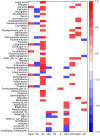Fungal and Bacterial Community Dynamics in the Rhizosphere and Rhizoplane of Diabelia spathulata in Relation to Soil Properties
- PMID: 40792181
- PMCID: PMC12337736
- DOI: 10.1080/12298093.2025.2535775
Fungal and Bacterial Community Dynamics in the Rhizosphere and Rhizoplane of Diabelia spathulata in Relation to Soil Properties
Abstract
Diabelia spathulata, a rare deciduous shrub native to East Asia, is critically endangered in Korea, yet little is known about its interactions with soil fungal communities. This study presents the first comprehensive analysis of fungal and bacterial communities in the rhizoplane (RP), rhizosphere (RS), and surrounding soil (SS) of D. spathulata in its natural habitat on Mt. Cheonseong, South Korea. High-throughput sequencing of the ITS and 16S rRNA gene regions revealed distinct microbial assemblages across soil compartments. Fungal taxa such as Russula, Trechispora, and Capronia were enriched in RP and RS, highlighting their potential roles in nutrient cycling, organic matter (OM) decomposition, and symbiosis. In contrast, the SS exhibited greater fungal richness but lower specialization. Among bacteria, root-associated compartments were enriched with plant-beneficial genera such as Bacillus and Bradyrhizobium, while bulk soil hosted more generalist taxa. Soil physicochemical analyses showed higher OM and total nitrogen in RS compared to SS, indicating root-driven enrichment. Correlation and network analyses identified strong links between specific fungal and bacterial taxa and key soil properties including pH, OM, and cation exchange capacity. These results suggest that D. spathulata modulates its RS microbiome to enhance nutrient availability and stress tolerance. This study highlights the ecological significance of fungal communities in root-associated microhabitats and provides foundational knowledge for incorporating soil microbiota into conservation and habitat restoration efforts for endangered plant species.
Keywords: Diabelia spathulata; Rhizosphere microbiome; fungal diversity; root-associated fungi; soil properties.
© 2025 The Author(s). Published by Informa UK Limited, trading as Taylor & Francis Group on behalf of the Korean Society of Mycology.
Conflict of interest statement
No potential conflict of interest was reported by the author(s).
Figures






Similar articles
-
Effects of saffron-grape intercropping on saffron flower number and rhizosphere microbial community.BMC Microbiol. 2024 Dec 30;24(1):551. doi: 10.1186/s12866-024-03716-4. BMC Microbiol. 2024. PMID: 39736513 Free PMC article.
-
Impact of seasonal changes on root-associated microbial communities among phreatophytes of three basins in desert ecosystem.Front Plant Sci. 2025 Jul 4;16:1554879. doi: 10.3389/fpls.2025.1554879. eCollection 2025. Front Plant Sci. 2025. PMID: 40688685 Free PMC article.
-
Soil properties and plant functional traits have different importance in shaping rhizosphere soil bacterial and fungal communities in a meadow steppe.mSystems. 2025 Aug 19;10(8):e0057025. doi: 10.1128/msystems.00570-25. Epub 2025 Jul 8. mSystems. 2025. PMID: 40626779 Free PMC article.
-
Divergent biotic-abiotic mechanisms of soil organic carbon storage between bulk and rhizosphere soils of rice paddies in the Yangtze River Delta.J Environ Manage. 2025 Aug;389:126179. doi: 10.1016/j.jenvman.2025.126179. Epub 2025 Jun 20. J Environ Manage. 2025. PMID: 40543133
-
Continuous cropping obstacles in medicinal plants: Driven by soil microbial communities and root exudates. A review.Plant Sci. 2025 Oct;359:112686. doi: 10.1016/j.plantsci.2025.112686. Epub 2025 Jul 26. Plant Sci. 2025. PMID: 40721126 Review.
References
-
- Wang HX, Moore MJ, Barrett RL, et al. Plastome phylogenomic insights into the Sino‐Japanese biogeography of Diabelia (Caprifoliaceae). J Syst Evol. 2020;58(6):972–987. doi: 10.1111/jse.12560. - DOI
-
- Yi MH, Yoo ST, Jang JG.. Vegetation structure and growth environment of Diabelia spathulata (Siebold & Zucc.) Landrein population in Mt. Cheonseong, Korea. Korean J Plant Res. 2021;34:346–361. doi: 10.7732/kjpr.2021.34.4.346. - DOI
-
- Landrein S. Diabelia, a new genus of tribe Linnaeeae subtribe Linnaeinae (Caprifoliaceae). Ann Bot. 2010;120:257–269. doi: 10.11646/phytotaxa.3.1. - DOI
-
- Korea National Arboretum . Rare plants in Korea. Pocheon, Korea: Korean National Arboretum of the Korea Forest Service; 2012.
LinkOut - more resources
Full Text Sources
